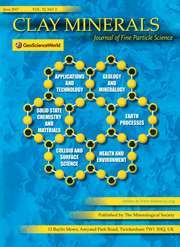Crossref Citations
This article has been cited by the following publications. This list is generated based on data provided by
Crossref.
WILD, A.
and
KEAY, J.
1964.
CATION‐EXCHANGE EQUILIBRIA WITH VERMICULITE.
Journal of Soil Science,
Vol. 15,
Issue. 2,
p.
135.
Bissada, K. K.
and
Johns, W. D.
1969.
Montmorillonite-Organic Complexes - Gas Chromatographic Determination of Energies of Interactions.
Clays and Clay Minerals,
Vol. 17,
Issue. 4,
p.
197.
Mortland, M.M.
1970.
Vol. 22,
Issue. ,
p.
75.
Walker, G. F.
1975.
Soil Components.
p.
155.
Suquet, H.
Prost, R.
and
Pezerat, H.
1977.
Étude par spectroscopie infrarouge de l'eau adsorbée par la saponite-calcium.
Clay Minerals,
Vol. 12,
Issue. 2,
p.
113.
Kitajima, K.
Daimon, N.
and
Kondo, R.
1978.
Hydration and dehydration characteristics of synthetic water-swelling fluoromicas: comparisons between silicates and germanates.
Clay Minerals,
Vol. 13,
Issue. 2,
p.
167.
Stone, M. H.
and
Wild, A.
1978.
The reaction of ammonia with vermiculite and hydrobiotite.
Clay Minerals,
Vol. 13,
Issue. 3,
p.
337.
Alcover, J. F.
and
Gatineau, L.
1980.
Structure de l'espace interlamellaire des vermiculites Ba monocouches.
Clay Minerals,
Vol. 15,
Issue. 2,
p.
193.
Rausell-Colom, J. A.
Fernandez, M.
Serratosa, J. M.
Alcover, J. F.
and
Gatineau, L.
1980.
Organisation de l'espace interlamellaire dans les vermiculites monocouches et anhydres.
Clay Minerals,
Vol. 15,
Issue. 1,
p.
37.
Graf v. Reichenbach, H.
and
Beyer, J.
1995.
Dehydration and rehydration of vermiculites: II. Phlogopitic Ca-vermiculite.
Clay Minerals,
Vol. 30,
Issue. 4,
p.
273.
Graf v. Reichenbach, H.
and
Beyer, J.
1997.
Dehydration and rehydration of vermiculites: III. Phlogopitic Sr- and Ba-vermiculite.
Clay Minerals,
Vol. 32,
Issue. 4,
p.
573.
Poyato, J.
Pérez-Maqueda, L. A.
Justo, A.
and
Balek, V.
2002.
Emanation Thermal Analysis of Natural and Chemically-Modified Vermiculite.
Clays and Clay Minerals,
Vol. 50,
Issue. 6,
p.
791.
Pérez-Maqueda, L. A.
Balek, V.
Poyato, J.
Pérez-Rodríquez, J. L.
Šubrt, J.
Bountsewa, I. M.
Beckman, I. N.
and
Málek, Z.
2003.
Study of natural and ion exchanged vermiculite by emanation thermal analysis, TG, DTA and XRD.
Journal of Thermal Analysis and Calorimetry,
Vol. 71,
Issue. 3,
p.
715.
MORONTA, ALEXANDER
2004.
Clay Surfaces - Fundamentals and Applications.
Vol. 1,
Issue. ,
p.
321.


